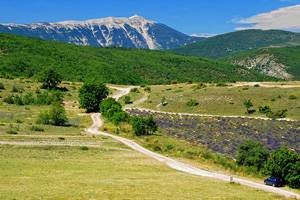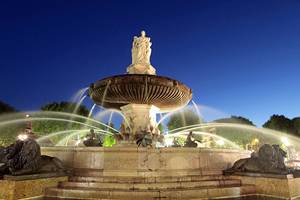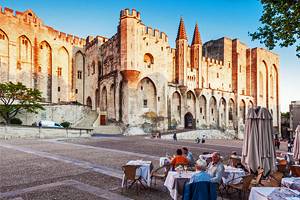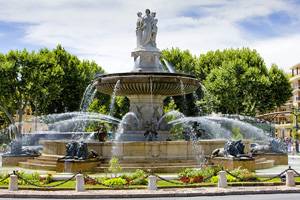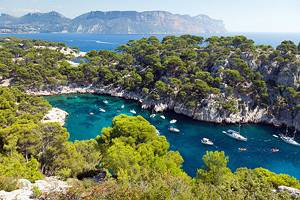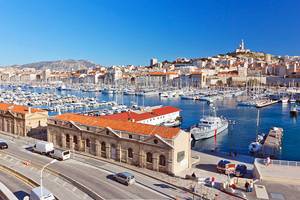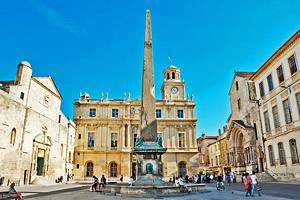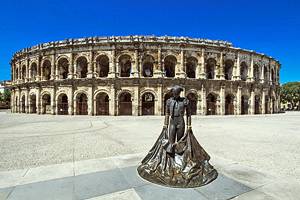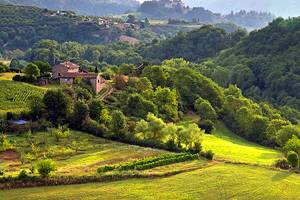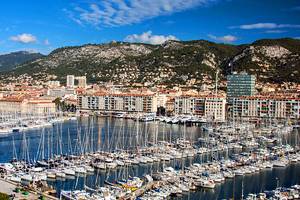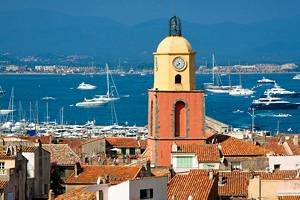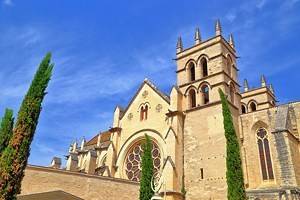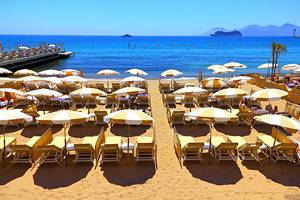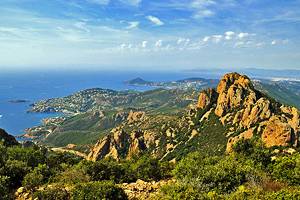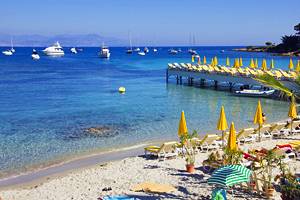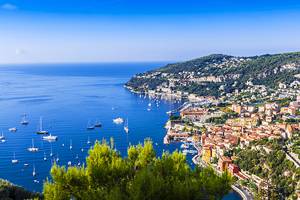Attractions of Parc Naturel Régional du Luberon, Provence
A wonderfully off-the-beaten-path area of Provence, the Luberon beckons you to slow down and enjoy life. The area's enchanting small towns and unspoiled countryside burst with beauty and joie de vivre. These alluring destinations are some of the top attractions of Provence.
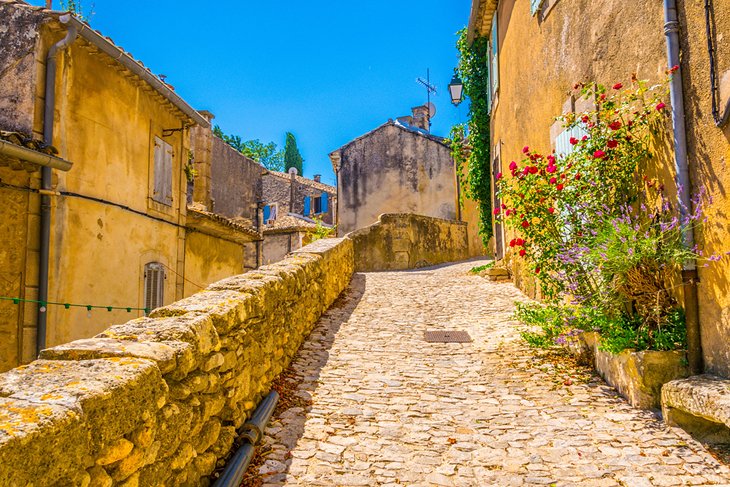
The entire Luberon falls within the boundaries of a UNESCO-listed biosphere reserve/regional park based around the Montagne du Lubéron (Luberon Mountain range). The Parc Naturel Régional du Lubéron encompasses rugged limestone mountains, gently rolling hills, lush woodlands, verdant valleys, and more than 70 communities.
Quaint medieval villages and historic stone farmhouses are scattered throughout the patchwork of lavender fields, orchards, and olive groves.
Exploring this picturesque area requires a car, but a driving itinerary is easy to do. Many of the region's tourist destinations are only about 10 to 30 kilometers apart. With a car and one week of vacation time, you could easily visit all of the villages and towns on this list.
Whatever your holiday schedule, be sure to visit a mix of tiny villages (such as Gordes, Gargas, Joucas, and Lacoste) and larger towns (like Cavaillon, Bonnieux, and Apt).
In the small villages, you will enjoy wandering the cobbled lanes, soaking up the relaxing Provençal ambience at outdoor café terraces, and savoring the authentic regional cuisine. The larger towns have more energy and cultural attractions, such as bustling open-air markets, museums, and lively summertime festivals.
Also not to be missed are local specialties, such as the melons of Cavaillon, renowned for their delicate flavor, and the prized black truffles, which are found on truffle hunts outside the village of Ménerbes and in the surrounding terrain.
Discover favorite regional dishes of the Luberon like ratatouille (seasonal stewed vegetables), pistou (similar to minestrone soup), pissaladière (onion tart), tapenade (olive spread), chestnut soup, and cherry clafouti (a custard dessert baked with cherries).
Plan your trip with our list of the best places to visit and things to do in the Parc Naturel Régional du Lubéron.
Gordes: A Picture-Perfect Hilltop Village
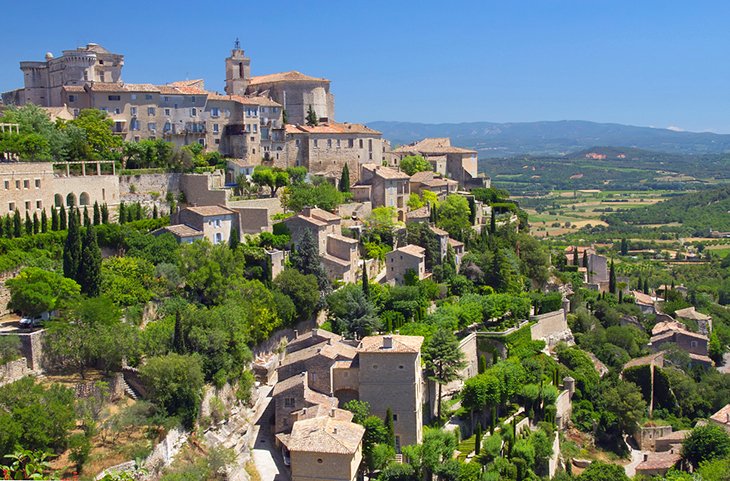
This picture-perfect hilltop village is justifiably listed as one of the Plus Beaux Villages de France. Thanks to its beauty, the village began to attract artists in the mid-20th century, including Victor Vasarely, Marc Chagall, and Pol Mara.
As a typical village perché (perched village), Gordes stands dramatically on a steep promontory. (40 kilometers from Avignon). Its nearly inaccessible location protected against invasions during the Middle Ages. Today, the elevation of the town delights tourists with sweeping panoramic views.
The Château de Gordes dominates the village with its enormous defensive walls and crenellated towers. This well-preserved Monument Historique is now a cultural center that displays temporary exhibits. Nearby at the Place du Château are many cafés, restaurants, and souvenir shops.
It's possible to enjoy an ultra-luxurious overnight stay within the historic village of Gordes. The Airelles Gordes, La Bastide resort offers five-star accommodations overlooking the landscape of olive groves, forests, and mountains. Guests rooms are decorated in the classic French style of the 18th century, complete with antiques and fine art. The property includes an outdoor swimming pool and several gourmet restaurants.
Read More: Attractions & Places to Visit in the Haut-Vaucluse, Provence
Ménerbes from A Year in Provence
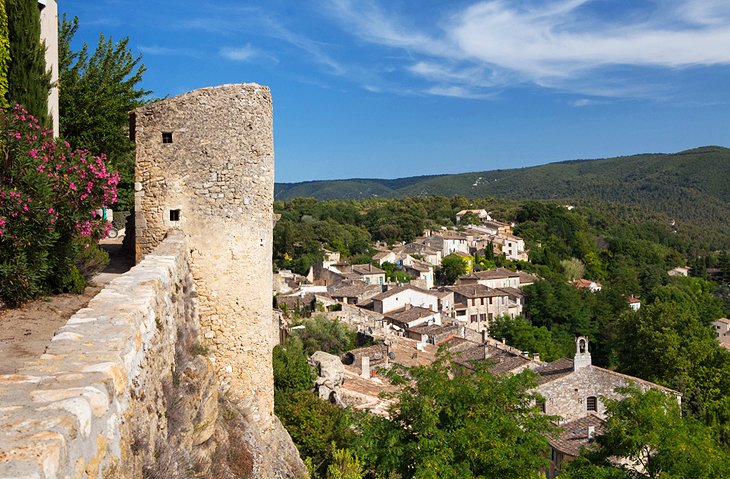
Ménerbes clings to a rocky outcrop (about 15 kilometers from Gordes) overlooking the Luberon Valley, Mont Ventoux, and the Vaucluse mountains. The village is listed as one of the Plus Beaux Villages de France because of its gorgeous scenery and small-town charm.
This winsome country village began to attract writers and artists (such as Picasso and Nicolas de Staël) in the 20th century. But it was author Peter Mayle who really put the village on the tourist map with his novel A Year in Provence (published in 1989), which was set in Ménerbes.
The village's atmospheric streets are lined with old stone houses and historic monuments. Highlights are the 16th-century Eglise Saint-Luc; the 18th-century Chapelle Saint-Blaise; and Le Castelet, a medieval château built on the ruins of a 12th-century fortress.
Renowned for its gastronomy, Ménerbes hosts a traditional open-air Provençal market every Thursday morning, with stalls selling vegetables, fruits, cheese, bread, specialty food products from local farms, artisanal ceramics, and colorful Provençal linens. The village also has a handful of restaurants that serve gourmet fare and casual cafés with sunny outdoor terraces.
Additional culinary experiences await at the Goat Cheese Market in May and at the Truffle Market held on the Sunday between Christmas and New Year's Day. Other truffle markets are held in Carpentras (40 kilometers away) and in Richerenches (90 kilometers away).
For those intrigued by the idea of truffle hunting, the Maison de la Truffe (an upscale restaurant that serves cuisine based on truffles) may on occasion organize outings to search for the prized Truffe du Périgord - also known as "black diamonds."
Several hiking trails depart from the village into the scenic countryside, alongside cherry tree orchards and vine-covered fields.
Read More:
Lourmarin: Provençal Festivals and Art de Vivre
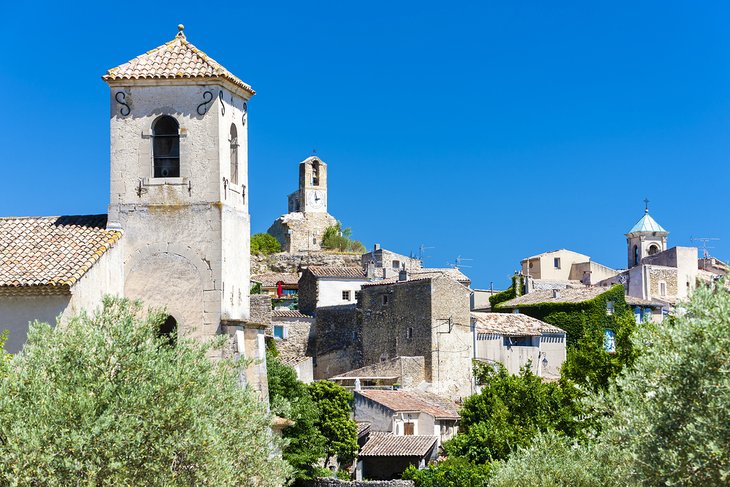
In a protected valley at the foot of the Luberon Mountains, Lourmarin is sheltered from the Mistral winds. That means the town enjoys many pleasant, sunny days.
This picturesque community, another one of the Plus Beaux Villages de France, offers a taste of the Provençal art de vivre (art of living). A traditional Provençal market is held on Friday mornings in the center of town.
The village is filled with outdoor cafés, bustling bistros, excellent restaurants, and inviting hotels, as well as artisan boutiques and art galleries. Atmospheric cobblestone streets lead to peaceful fountain-adorned squares and historic monuments.
The Eglise Saint-André et Saint-Trophime, a church founded in the 11th century and renovated in the 16th century, is an interesting blend of Romanesque and Gothic style. The village also has a Protestant temple, an austere house of worship built in the early 19th century.
An architectural highlight of Lourmarin is its Renaissance Château de Lourmarin, standing majestically on a hilltop overlooking the Lourmarin Valley, the Durance Plain, and the Montagne Sainte-Victoire. Views from the château's tower are exceptional.
The château and its art collection are owned by the Academy of Arts and Sciences of Aix-en-Provence, which collaborates with the Robert Laurent-Vibert Foundation to support an Artist in Residence program, bringing talented painters, sculptors, and musicians to the château during the summer months.
During the summer, the Château de Lourmarin hosts the Festival des Musiques d'Eté. This prestigious classical music festival includes piano recitals, jazz concerts, and opera performances.
Roussillon: A Village Perched on an Ochre Cliff
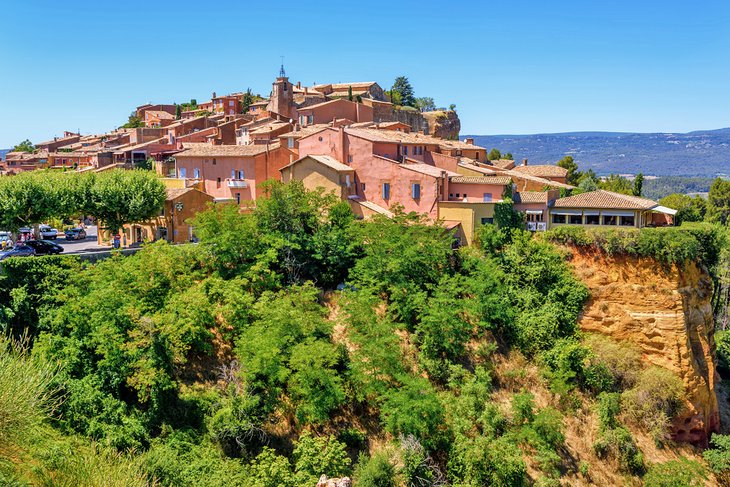
A stunning village perché, Roussillon enjoys a magnificent setting above an ochre cliff. The charm and beauty of Roussillon have earned it a designation on the Plus Beaux Villages de France list.
To enter the historic village, visitors must walk through the Clock Tower. From here, it's an uphill walk along the narrow steps of the Rue de l'Arcade to the Place de la Mairie.
Near the village church, the Eglise Saint-Michel, is the Place du Castrum, where a terrace affords spectacular panoramas of the countryside. More amazing vistas can be seen from the Rue des Bourgades.
Roussillon is found between the Plateau de Vaucluse and the Montagne du Lubéron (17 kilometers from Ménerbes and 10 kilometers away from Gordes) in a distinct landscape. To discover the spectacular scenery, take a hike along the Sentier des Ocres (Ochre Trail), a walking path where ruddy ochre cliffs and outcrops punctuate the landscape.
Just outside of the village are impressive ochre rock formations, the Chaussée des Géants (Street of the Giants), and the Val des Fées (Valley of the Fairies).
One of the most fascinating ochre sites is the Colorado Provençal (10 kilometers from Roussillon), found between the Luberon Mountains and the Monts de Vaucluse. Here, you can see the old quarries where the ochre deposits were once mined for commercial use (as natural pigments for stucco, paints, and dyes).
Read More: Tourist Attractions in Languedoc-Roussillon
Abbaye Notre-Dame de Sénanque
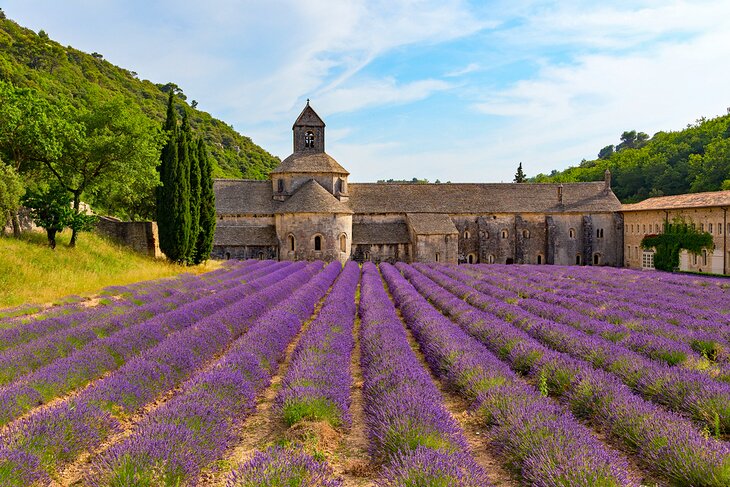
An iconic landscape and serene spiritual ambience await you at the Abbaye Notre-Dame de Sénanque, five kilometers from Gordes. This 12th-century Cistercian abbey nestles in a narrow valley, encircled by a peaceful environment of lavender fields and rolling hills.
The abbey is still a working monastery (the community lives according to the Rule of Saint Benedict) but is open to the public year-round. You may visit the abbey church, chapter house, former dormitory, and exquisite arcaded cloister to admire Romanesque architecture.
The Rule of Saint Benedict requires monks to participate in a life of prayer and work. At the Notre-Dame de Sénanque Abbey, the monks dedicate a considerable amount of time to work in farming activities: growing olive trees and lavender plants. The olives and lavender blossoms are gathered by hand to create olive oil and lavender honey, which is sold on-site at the abbey's boutique.
You may attend religious services in the abbey church; services are held seven times every day.
Spiritual seekers are welcomed for silent retreats, which include meals, community prayer services, and accommodations. You may arrive for a retreat any day except Sunday morning or Monday. Retreats are up to eight days in length.
Cavaillon: A Melon Festival and Rich Jewish Heritage
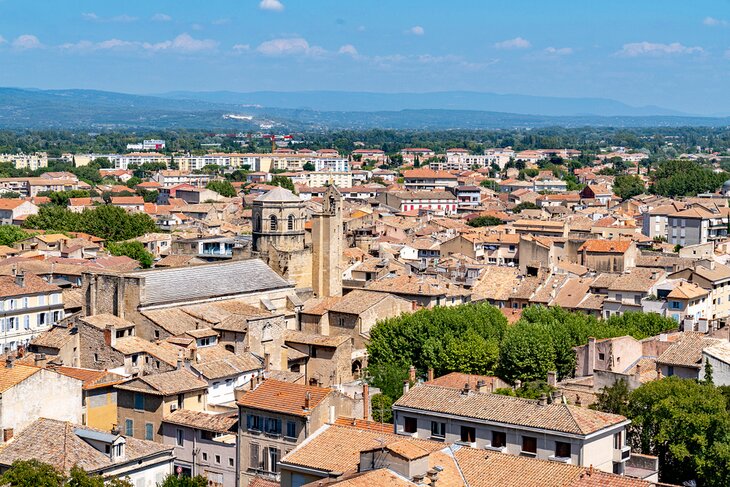
In the sun-soaked countryside at the edge of the Luberon Natural Regional Park, the little provincial town of Cavaillon is the center of melon-growing in Provence. The village also has an interesting cultural heritage.
The Cathédrale Saint-Véran, built in the 12th century, exemplifies Romanesque Provençal style. Its exterior is austere, but the interior is beautifully decorated with capitals in the apse and an exquisite cloister.
Cavaillon also has a splendid synagogue (on the Rue Hébraïque), a masterpiece of Jewish-Provençal (Comtadin) architecture built in the 15th and 18th centuries that is classified as a Monument Historique. Although it is no longer used as a synagogue, the building has been well preserved and now houses the Musée Juif Comtadin (guided tours only), which illustrates the history of the local Jewish population going back to the 13th century.
Another must-see cultural attraction in Cavaillon is the Musée Archéologique de l'Hôtel-Dieu. This impressive archaeology collection displays artifacts uncovered in the Cavaillon area, from the Gallo-Roman period, the Roman era, and the Middle Ages.
To celebrate the melon season, Cavaillon hosts a Melon Festival in early July. The festival includes two days of melon tastings, banquets, recipe demonstrations, a cooking competition, and a parade accompanied by brass bands.
Cavaillon's weekly outdoor market is held on Monday mornings on the main street in the center of town.
Read More: Things to Do in Avignon
The Bustling Market Town of Bonnieux
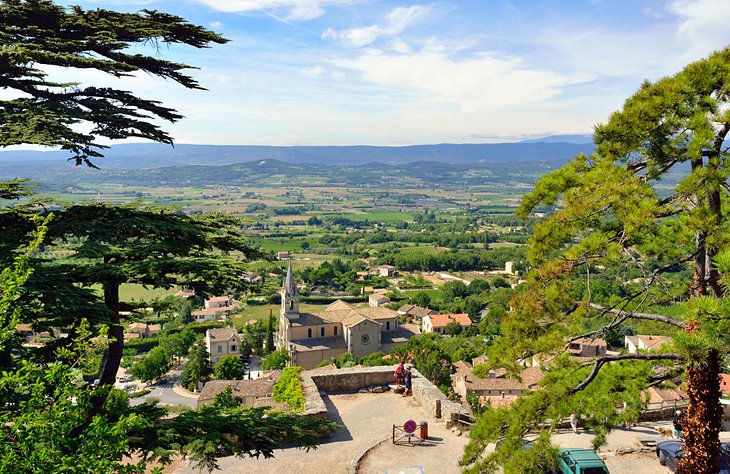
A hub of activity in the Luberon, the hilltop village of Bonnieux brims with restaurants, cafés, and hotels. The village is found on the northern slope of the Luberon Mountain, about 10 kilometers from Ménerbes and 12 kilometers from Roussillon.
Be sure to visit the Vieille Eglise (Old Church), a Romanesque monument built between the 12th and 15th centuries and dedicated to Saint Gervais. The Vieille Eglise is open to the public year-round (on weekends during low season and daily during high season), free of admission charge.
The Vieille Eglise is reached by a flight of steps from the Place de la Liberté. Surrounded by mighty cedar trees, the church stands high above the town with spectacular views of the landscape. The panorama extends from the Bassin d'Apt to Gordes and Roussillon and across the Plateau de Vaucluse to Mont Ventoux.
Bonnieux also has a noteworthy museum, the Musée de la Boulangerie (12 Rue de la République) which explores the history of bread and its role in civilization from antiquity to the present day.
On market days (Friday mornings), Bonnieux becomes a bustling scene of colorful stalls selling fresh fruits, vegetables, jams, local cheese, quiches, specialties such as tapenade, and Provençal fabrics.
Ansouis
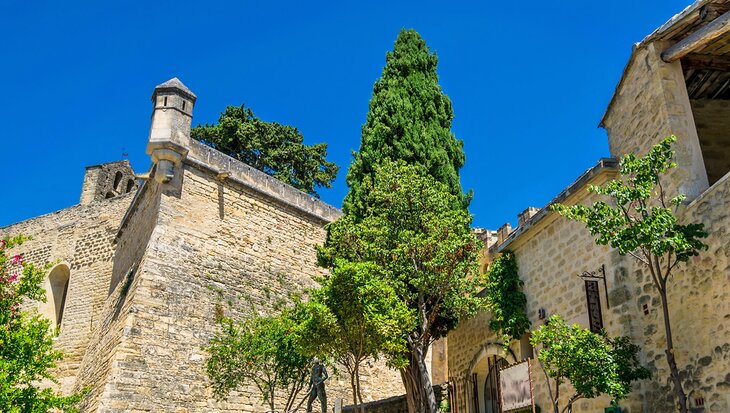
A bucolic landscape of vineyards, orchards, and olive groves surrounds the perched village of Ansouis. In its lovely, elevated locale, the town looks out to the Grand Lubéron mountain range. Listed as one of the Plus Beaux Villages de France, this medieval walled village features narrow cobblestone lanes and old stone buildings with pastel-painted shutters.
The majestic Château d'Ansouis presides over the town. Built between the 12th and 17th centuries, the castle has been completely refurbished, which is unusual for a medieval fortress in France. The rooms are decorated with furniture and tapestries from the 17th and 18th centuries. The castle is privately owned but is open to the public for guided tours (in French only).
Another historic monument not to be missed is the Eglise Saint-Martin, which dates to the 12th century. The somber exterior of this Romanesque church contrasts with its splendid interior, featuring an ornate altarpiece.
A wonderful addition to any Provence tour itinerary, Ansouis is about 10 kilometers from Lourmarin and about 30 kilometers from Aix-en-Provence.
Archaeology and Artisan Crafts in Apt
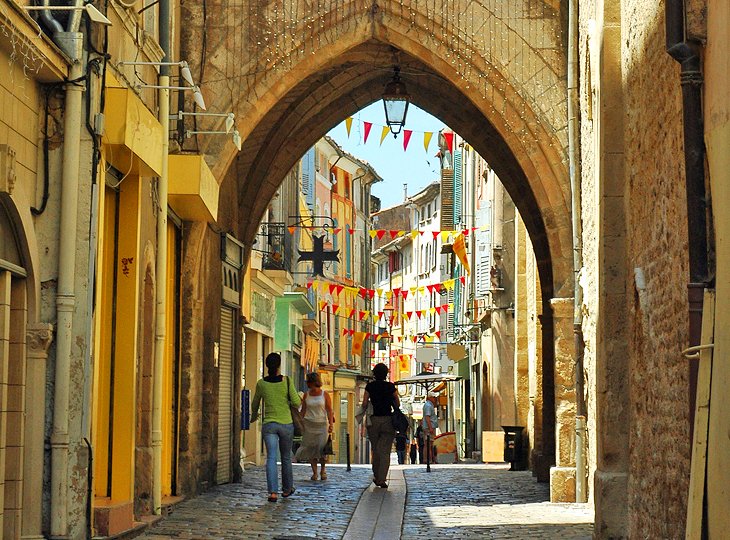
This captivating little village perches on a hilltop in the heart of the Luberon. The town's size and location make it a good base for exploring the region.
Apt was on the Via Domitia (the old Roman road), and this heritage can be seen at the Musée d'Histoire et d'Archéologie, which displays Gallo-Roman antiquities.
The fascinating layers of the town's multifaceted history are revealed at the Cathédrale Sainte-Anne, originally a Romanesque church that was altered in the 14th and 17th centuries. In the cathedral's Baroque Chapelle Sainte-Anne is a reliquary of Saint Anne. The Treasury possesses reliquaries from Limoges and illuminated manuscripts.
Apt draws crowds to its Saturday morning open-air Provençal market, which is one of the largest and busiest in the region. At the many stalls spread throughout the town's streets and squares, vendors sell fresh fruits and vegetables; local food products; as well as flowers, fabrics, soaps, perfumes, and other locally made specialty items.
Tiny Hilltop Village of Gargas in the "Route de l'Ocre"
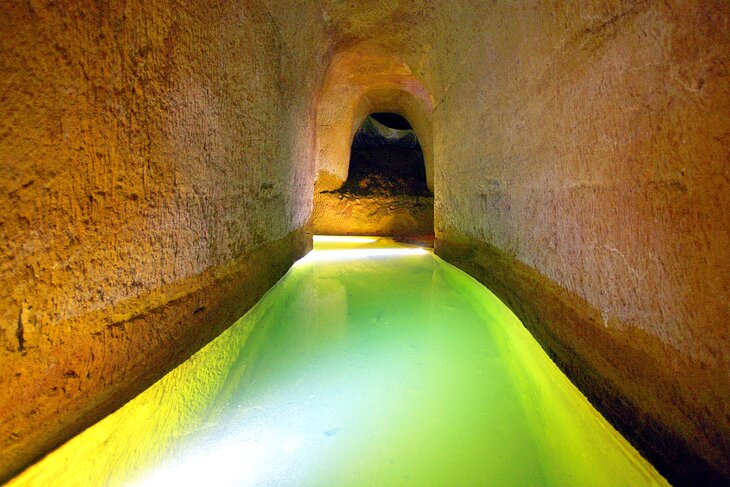
About five kilometers away from Apt, the tiny village of Gargas is found in the forested rolling hills of the Luberon's ochre landscape.
Ochre mining was once an important industry of the area. Although production has declined, ochre deposits from nearby quarries are still used to produce stucco, ceramics, pigments for paint and textiles, and other products.
Tourists can visit the Mines de Bruoux in Gargas to take a guided tour of the ochre caves (650 meters of maze-like galleries) that were carved out by miners while exploiting the valuable mineral.
Other attractions in the town include the 17th-century parish church, the Eglise Saint-Denis, which is adorned with lavish tapestries and paintings, and the stately Château des Condés, now the Hôtel de Ville (Town Hall).
Foodies will appreciate the culinary heritage of Gargas. The town is known for its artisanal preserved fruits and jams. Nearby in Beaumettes (17 kilometers away) is the Confiserie Saint-Denis, an artisanal confectionary shop that has crafted fruits confits (candied fruit) in the old-fashioned way since 1873. In fact, candied fruits have been a local tradition since the 14th century.
Another regional gastronomic specialty is Banon cheese. Designated with an AOC (Appellation d'Origine Contrôlée) label for its guarantee of quality and authenticity, Banon cheese is made from unpasteurized goat's milk and encased in chestnut tree leaves. This unique cheese is prized for its slightly sweet, thoroughly creamy, and delicately nutty flavor.
For those who would like to further discover the local food culture, it's recommended to visit Gargas on a Wednesday, when the town hosts a traditional outdoor Provençal market.
Five kilometers from Gargas is the Coquillade Provence, a five-star resort hotel tucked away in the vine-covered rolling hills. This Relais & Châteaux property boasts two large outdoor swimming pools, an upscale spa, and three restaurants plus a poolside snack bar.
Cadenet: Culture, Cuisine, and Festivals
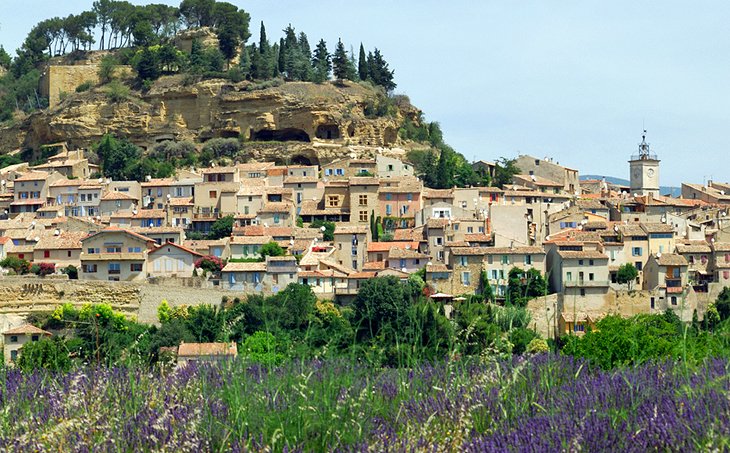
This medieval hilltop village presides over the banks of the Durance River about five kilometers from Lourmarin. Steeped in history, Cadenet has the alluring ambience of a Provençal village perché with its idyllic views and quiet, old streets.
The village spirals out in concentric circles around the hillsides and is dominated by the ruins of an 11th-century château, while Cadenet's 17th-century parish church is outside the historic center. The church features a room filled with sacred relics and unique baptism fonts, which were made from fragments of an ancient Roman marble sarcophagus.
Cadenet is a great place to soak up the local culture and savor the cuisine. Throughout the year there are many cultural events and festivals.
On Monday mornings year-round, the town's traditional Provençal market attracts residents who come to shop for fresh fruit, vegetables, and other culinary items, as well as kitchenware. At the Cadenet farmers market, held on Saturday mornings from May through November, farmers and artisans sell seasonal products and handmade items.
Gourmands may want to stop for a meal at the Auberge La Fenière (Route de Lourmarin), a luxury hotel with a Michelin-starred gastronomic restaurant, Le Goût du Bonheur. During spring and summer, the restaurant's outdoor terrace is a delightful place to enjoy a leisurely meal.
Abbaye de Silvacane
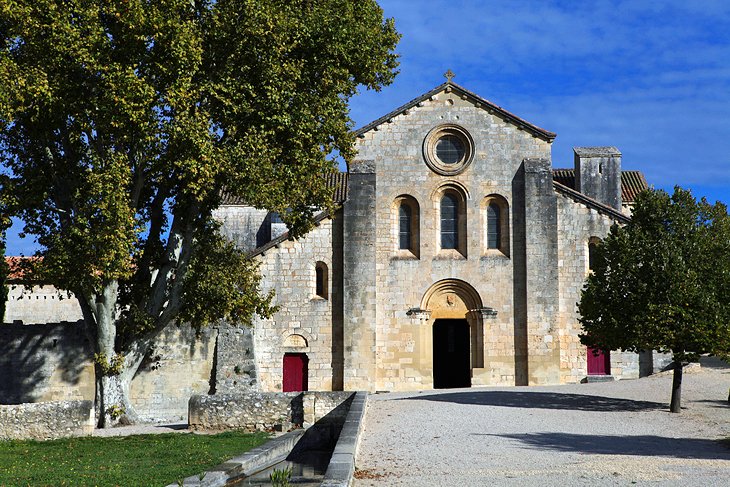
At the foot of the Montagne du Lubéron, the village of La Roque d'Anthéron conceals this remarkable 12th-century abbey. The name of the abbey comes from the Latin words "silva cannorum" (meaning "forest of reeds") and indicates that the area was formerly marshland.
Founded in 1144 and completed in 1230, the abbey is a gem of Cistercian architecture blending Romanesque and early Gothic styles. The cloister and monastery buildings were built from 1250 to 1300, while the refectory dates to the 15th century, revealing a later Gothic style with more elaborate vaulting.
Thanks to its inspiring architecture and serene setting, the abbey is popular as a venue for weddings, as well as other events. Throughout the year, and especially during summertime, the abbey hosts art exhibits, music concerts, and festivals.
The Abbaye de Silvacane is open to the public every day except Mondays from October through May (except Christmas, January 1st and May 1st) and every day from June through September. The admission fee includes an audioguide (available with English-language commentary) that you can use for a self-guided tour.
After visiting the abbey, you might want to get a snack or meal in the village of La Roque d'Anthéron. Less than two kilometers away, La Roque d'Anthéron has many restaurants, cafés, and ice cream shops.
The abbey is also just seven kilometers from Cadenet, another great dining place. The Auberge La Fenière (hotel) in Cadenet has a Michelin-starred restaurant.
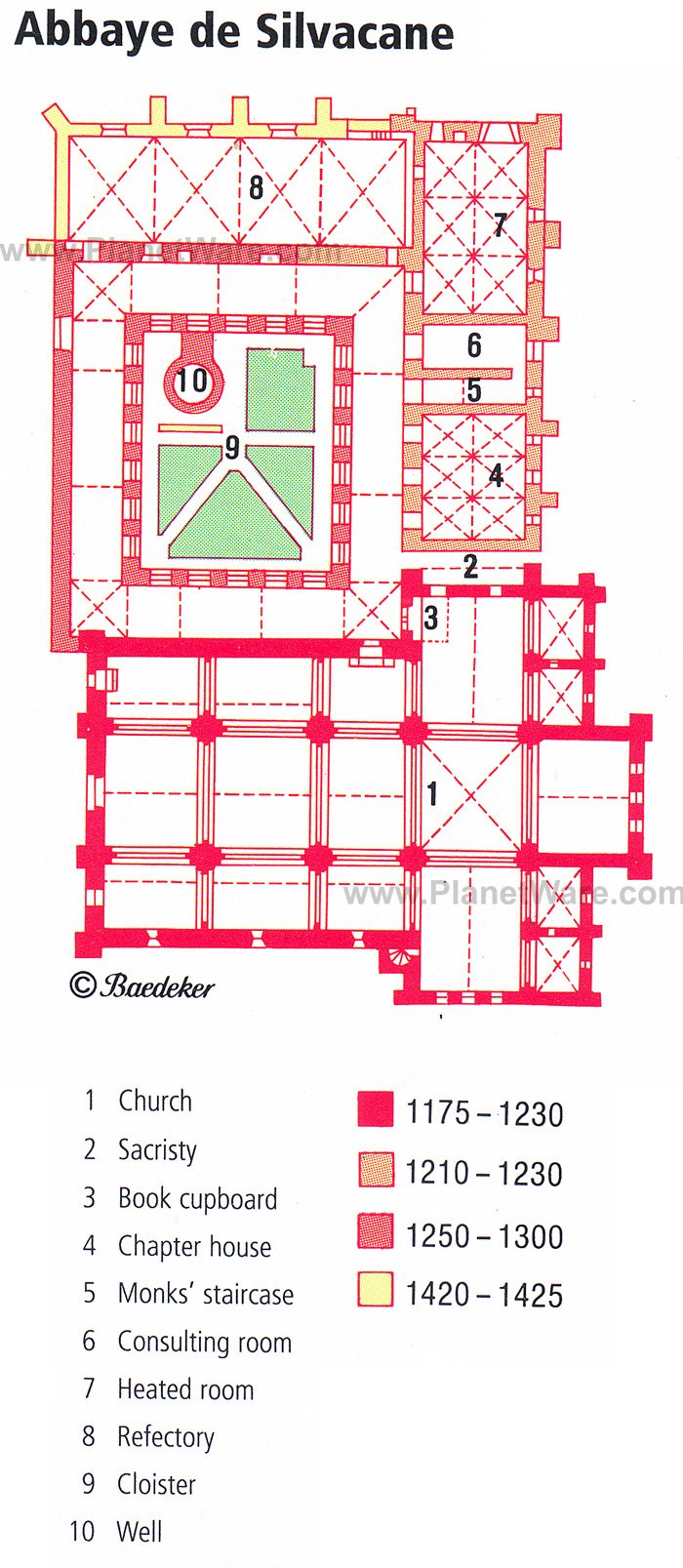
Cucuron
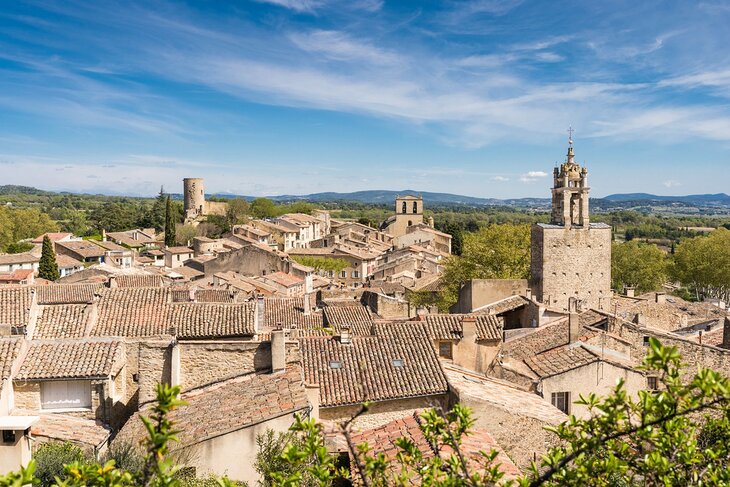
Continuing about seven kilometers away from Lourmarin is the village of Cucuron at the foot of the Luberon Mountain, the starting point of a hike up to Le Mourre Nègre summit.
Near the village of Lourmarin, a scenic viewpoint on the crest of the Grand Lubéron mountain range offers a magnificent panorama and fabulous photo ops.
Other attractions in Cucuron are the Romanesque and Gothic parish church and the Musée de Cucuron (also known as the Musée Marc Deydier), which displays Marc Deydier's archaeology and photography collections in the 17th-century Hôtel des Bouliers (mansion).
Quiet and Charming Village of Joucas
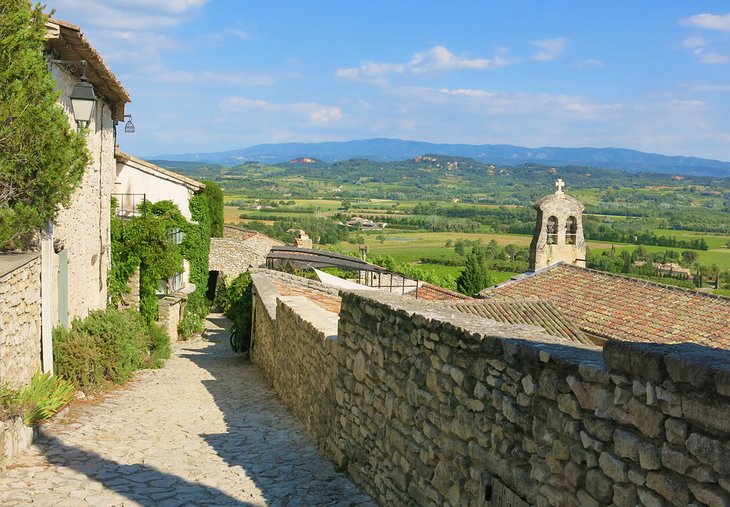
Joucas offers bucolic scenery and Provençal charm. Set on a wooded hillside, this village perché is distinguished by its traffic-free labyrinth of quaint cobbled streets, pedestrian staircases, narrow alleyways, and terraces with views of the surrounding landscape.
The houses feature characteristic architecture of the region: stone buildings with pastel shutters and red-tile roofs. You could easily spend a few hours wandering around to discover the charming hidden corners and quiet squares with refreshing fountains.
Looking out beyond the village, you can admire a patchwork of farmlands and vineyards in the plains. If you'd like to discover the scenery further, there is a trail just outside the town for hiking and nature walks.
Joucas is five kilometers from Roussillon and eight kilometers from Gordes.
Lacoste: A Dreamy Village Renovated by Pierre Cardin
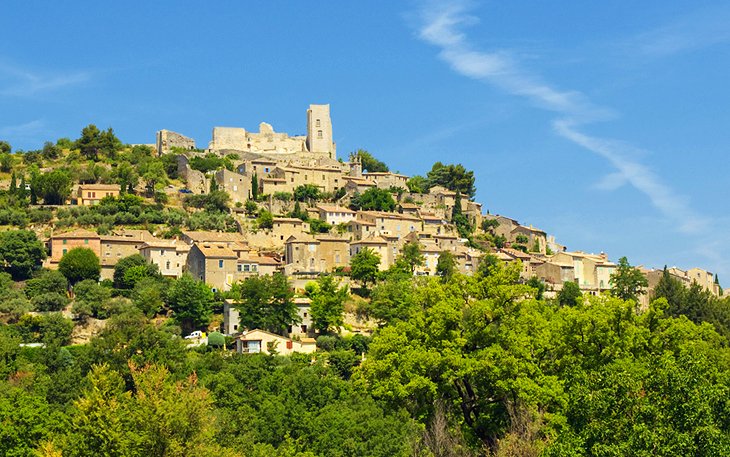
This tiny village perché delights you with its old-world charm. Characteristic features of the village include winding pedestrian lanes, medieval gateways, historic stone buildings with floral adornments, and a 12th-century parish church.
Lacoste owes much of its present beauty to renovations funded by the famous designer Pierre Cardin. The 11th-century Château de Lacoste, which crowns the village, was purchased by Cardin in 2001. The designer restored the castle from a state of ruin and redecorated the grand rooms in an eclectic designer style. The château is open to the public for visits in July and August.
During summertime, the château hosts two prestigious cultural events. The Festival de Lacoste (late July through mid-August), a festival of classical music, opera, theater, and dance; as well as the Festival de Cinema (early July), are held at outdoor performance venues within the castle grounds.
From the château as well as from other vantage points in the village, you can admire amazing views of the surrounding countryside. Panoramas extend to the Monts de Vaucluse and Mont Ventoux.
Several outdoor cafés in the village have scenic terraces. The Café de France serves classic French cuisine, coffee, refreshments, and desserts on an outdoor terrace with breathtaking vistas.
Lacoste is located about six kilometers from Bonnieux and eight kilometers from Ménerbes. From Lacoste, there is a gentle walking path through the Forêt des Cèdres (Cedar Forest).
Coustellet
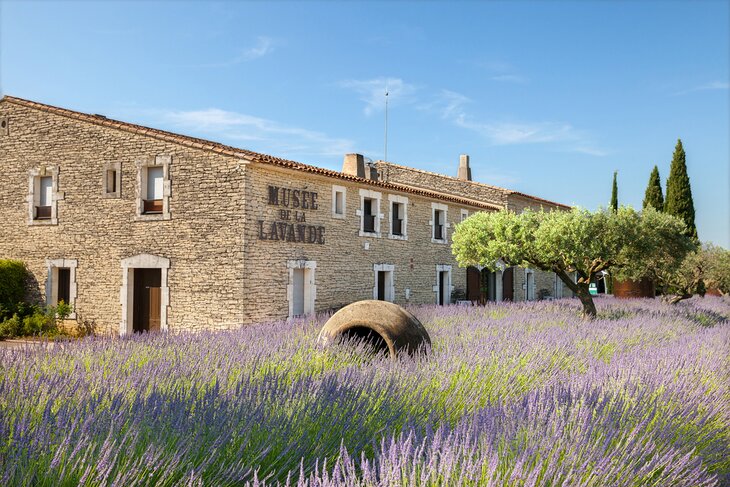
The Musée de la Lavande in Coustellet (eight kilometers from Gordes) educates visitors about the heritage of lavender farming; lavender-distilling techniques; and the botanical properties of the fragrant flowers. The museum's boutique sells soaps, cosmetic products, and fragrances made with Appellation d'Origine Protégée lavender essential oil.
Just outside of the Luberon Natural Regional Park are two top tourist destinations: the freshwater springs of Fontaine de Vaucluse (10 kilometers from Coustellet) and the town of Isle-sur-la-Sorgue (12 kilometers from Coustellet), which delights with its scenic canals, traditional Provençal market, and antique shops.
Abbaye Saint-Hilaire
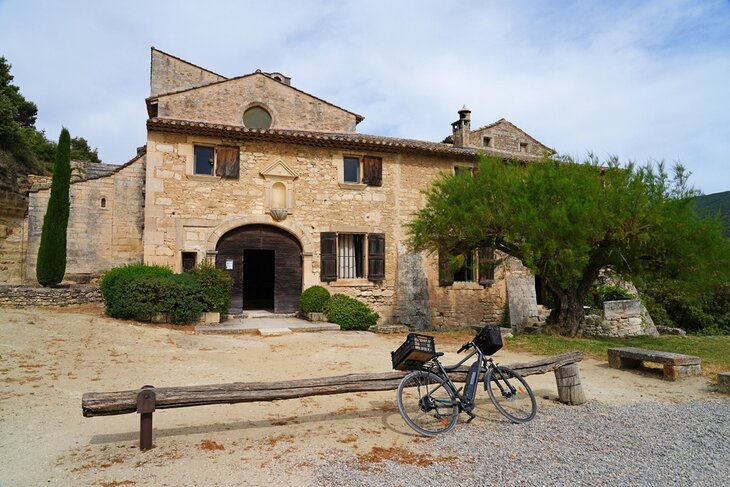
Designated as a Monument Historique, the Abbaye Saint-Hilaire dates back to the 12th century. In the 13th century, the abbey welcomed Louis IX (Saint Louis) on his return from the Crusades in the Holy Land.
This former Carmelite monastery has the calming ambience of a spiritual retreat. Although the site is privately owned, tourists may visit from April through November.
The Abbaye Saint-Hilaire is about four kilometers away from the village of Ménerbes.
Address: 2950 Route de Lacoste, 84560 Ménerbes




